 W
WAn icon or ikon is a religious work of art, most commonly a painting, in the cultures of the Eastern Orthodox, Oriental Orthodox, the Roman Catholic, and certain Eastern Catholic churches. They are not simply artworks; "an icon is a sacred image used in religious devotion". The most common subjects include Christ, Mary, saints and angels. Although especially associated with portrait-style images concentrating on one or two main figures, the term also covers most religious images in a variety of artistic media produced by Eastern Christianity, including narrative scenes, usually from the Bible or lives of saints.
 W
WAcheiropoieta — also called Icons Made Without Hands — are Christian icons which are said to have come into existence miraculously; not created by a human. Invariably these are images of Jesus or the Virgin Mary. The most notable examples that are credited by tradition among the faithful are, in the Eastern church the Mandylion, also known as the Image of Edessa, and the Hodegetria, and several Russian icons, and in the West the Shroud of Turin, Veil of Veronica, Our Lady of Guadalupe, and Manoppello Image. The term is also used of icons that are only regarded as normal human copies of a miraculously created original archetype.
 W
WIn the Eastern Orthodox Church, Aeiparthenos is the title of the Theotokos which refers to the "Ever Virgin" Mary, mother of Jesus, thus affirming the doctrine of the Perpetual virginity of Mary.
 W
WThe Ancha Icon of the Savior, known in Georgia as Anchiskhati, is a medieval Georgian encaustic icon, traditionally considered to be the Keramidion, a "holy tile" imprinted with the face of Jesus Christ miraculously transferred by contact with the Image of Edessa (Mandylion). Dated to the 6th-7th century, it was covered with a chased silver riza and partly repainted in the following centuries. The icon derives its name from the Georgian monastery of Ancha in what is now Turkey, whence it was brought to Tbilisi in 1664. The icon is now kept at the National Art Museum of Georgia in Tbilisi.
 W
WThe Antivouniotissa Museum is a museum of post-Byzantine religious art of the Cretan and early Heptanese schools in Corfu, Greece. It is located in the former church of the Holy Mother of God Antivouniotissa
 W
WIn Christian iconography, Christ Pantocrator is a specific depiction of Christ. Pantocrator or Pantokrator, usually translated as "Almighty" or "all-powerful", is derived from one of many names of God in Judaism.
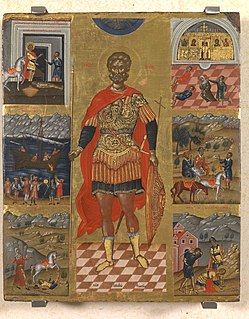 W
WCretan School describes an important school of icon painting, under the umbrella of post-Byzantine art, which flourished while Crete was under Venetian rule during the late Middle Ages, reaching its climax after the Fall of Constantinople, becoming the central force in Greek painting during the 15th, 16th and 17th centuries. The Cretan artists developed a particular style of painting under the influence of both Eastern and Western artistic traditions and movements; the most famous product of the school, El Greco, was the most successful of the many artists who tried to build a career in Western Europe, and also the one who left the Byzantine style farthest behind him in his later career.
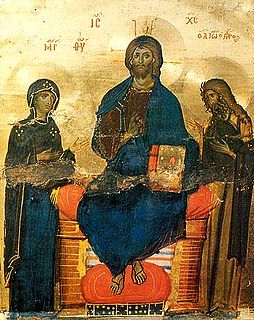 W
WIn Byzantine art, and later Eastern Orthodox art generally, the Deësis or Deisis, is a traditional iconic representation of Christ in Majesty or Christ Pantocrator: enthroned, carrying a book, and flanked by the Virgin Mary and St. John the Baptist, and sometimes other saints and angels. Mary and John, and any other figures, are shown facing towards Christ with their hands raised in supplication on behalf of humanity.
 W
WAn encolpion is a medallion with an icon in the center worn around the neck by Orthodox and Eastern Catholic bishops. The icon is normally surrounded by jewels and topped by an Eastern-style mitre. It often also has a small jewelled pendant hanging down at the bottom. The engolpion is suspended from the neck by a long gold chain, sometimes made up of intricate links. A portion of the chain will often be joined together with a small ring behind the neck so that it hangs down the back. Engolpia come in many different shapes, including oval, rhombus, square, or a double-headed eagle. In antiquarian contexts, an "encolpion cross" is a pectoral cross of the Byzantine period.
 W
WThe Epitaphios is a Christian religious icon, typically consisting of a large, embroidered and often richly adorned cloth, bearing an image of the dead body of Christ, often accompanied by his mother and other figures, following the Gospel account. It is used during the liturgical services of Good Friday and Holy Saturday in the Eastern Orthodox Churches, as well as those Eastern Catholic Churches, which follow the Byzantine Rite. It also exists in painted or mosaic form, on wall or panel.
 W
WHell icons are alleged icons with images of Devil hidden under the primer, the riza or the painted layer. Also, the image of saints could include horns hidden under the paint.
 W
WThe Hetoimasia, Etimasia, prepared throne, Preparation of the Throne, ready throne or Throne of the Second Coming is the Christian version of the symbolic subject of the empty throne found in the art of the ancient world, whose meaning has changed over the centuries. In Ancient Greece it represented Zeus, chief of the gods, and in early Buddhist art it represented the Buddha. In Early Christian art and Early Medieval art it is found in both the East and Western churches, and represents either Christ, or sometimes God the Father as part of the Trinity. In the Middle Byzantine period, from about 1000, it came to represent more specifically the throne prepared for the Second Coming of Christ, a meaning it has retained in Eastern Orthodox art to the present.
 W
WThe Holy Trinity is an important subject of iconographic representation in Eastern Orthodox Christianity, and has a rather different treatment from depictions in the Western Churches. There are two different types of Holy Trinity icons: the Old Testament Trinity and the New Testament Trinity.
 W
WThe icon corner, sacred corner or red corner, is a small worship space prepared in the homes of Eastern Orthodox, Greek-Catholic and Roman Catholic Christians. It also appears in homes of Rodnovers and have pre-Christian roots. The analogous concept in Western Christianity is the home altar.
 W
WIn Eastern Christianity, an iconostasis is a wall of icons and religious paintings, separating the nave from the sanctuary in a church. Iconostasis also refers to a portable icon stand that can be placed anywhere within a church. The iconostasis evolved from the Byzantine templon, a process complete by the 15th century.
 W
WA Madonna is a representation of Mary, either alone or with her child Jesus. These images are central icons for both the Catholic and Orthodox churches. The word is from Italian ma donna 'my lady'. The Madonna and Child type is very prevalent in Christian iconography, divided into many traditional subtypes especially in Eastern Orthodox iconography, often known after the location of a notable icon of the type, such as the Theotokos of Vladimir, Agiosoritissa, Blachernitissa, etc., or descriptive of the depicted posture, as in Hodegetria, Eleusa, etc.
 W
WThe National Iconographic Museum "Onufri" is an Albanian national museum dedicated to Byzantine art and iconography in Berat, Albania. The museum is located inside the Church of the Dormition of St Mary in the castle quarter Berat. The museum was named to honor Onufri, an Albanian painting Headmaster of the 16th century.
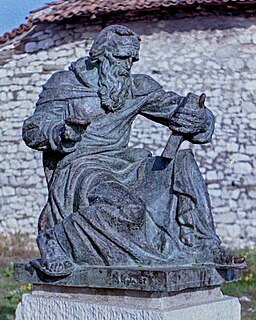 W
WOnufri Argitis or Onoufrios of Neokastro or Onoufrios Argytes was an Orthodox icon painter and Archpriest of Elbasan, active in the 16th century in southern Albania and south-western Macedonia. His works are characterized by post-Byzantine and Venetian influences. He also painted portraits, landscapes, and churches.
 W
WOrans, a loanword from Medieval Latin ōrāns translated as one who is praying or pleading, also orant or orante, is a posture or bodily attitude of prayer, usually standing, with the elbows close to the sides of the body and with the hands outstretched sideways, palms up. It was common in early Christianity and can frequently be seen in early Christian art. In modern times, the orans position is still preserved within parts of the Catholic, Orthodox, Anglican and Lutheran liturgies, Pentecostal and charismatic worship, and the ascetical practices of some religious groups.
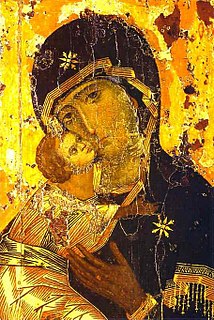 W
WA palladium or palladion is an image or other object of great antiquity on which the safety of a city or nation is said to depend. The word is a generalization from the name of the original Trojan Palladium, a wooden statue (xoanon) of Pallas Athena that Odysseus and Diomedes stole from the citadel of Troy and which was supposedly later taken to the future site of Rome by Aeneas, where it remained until perhaps transferred to Constantinople and lost sight of after the conversion of the Empire to Christianity.
 W
WPanachranta is a type of icon in the Eastern Orthodox Church, that refers to the all immaculate Virgin Mary, the Theotokos.
 W
WPodea is a kind of apron, that clearly designates a cloth hung at the foot of an icon in Orthodox Church, which often accompanies it in religious processions. This hanging often is embroidered with religious scenes or figures of the saints and liturgical writing. The image on a podea might either double or complement the subject of the icon: an epigram by Nicholas Kallikles describes a podea for the icon of the Theotokos at the Hodegon Monastery as “an image of the image”. It is also known as 'poderes skenos', 'kraspedon', 'pterygiori' and 'emprostalion'.
 W
WA proskynetarion is a monumental icon of the Eastern Orthodox Church usually depicting Christ, the Virgin Mary, or the patron saint of a church.
 W
WA riza or oklad, sometimes called a "revetment" in English, is a metal cover protecting an icon. It is usually made of gilt or silvered metal with repoussé work and is pierced to expose elements of the underlying painting. It is sometimes enameled, filigreed, or set with artificial, semi-precious or even precious stones and pearls.Although the practice of using rizas originated in Byzantine art, the Russian term is often applied to Greek icons; in Greek the term is επένδυση ("coating"). Icons are described as επάργυρες or επίχρυσες: silver-covered and gold-covered, respectively.
 W
WStroganov School is a conventional name for the last major Russian icon-painting school, which thrived under the patronage of the fabulously rich Stroganov family of merchants in the late 16th and 17th century.
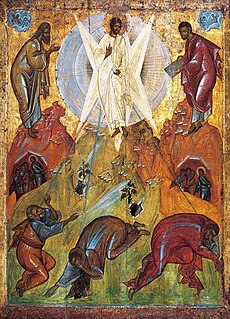 W
WTheophanes the Greek was a Byzantine Greek artist and one of the greatest icon painters of Muscovite Russia, and was noted as the teacher and mentor of the great Andrei Rublev.
 W
WTsata is a form of jewelry in the shape of a turned over crescent, typically made from gold or silver. It is placed at the bottom of a riza as a part of the icon decoration in the Eastern Orthodox Church. Tsata looks like a neck ring. The word derives from the Old Church Slavonic world tsęta which in turn derives from Latin: centus. It is specifically attached to the riza so that it is placed under the face of a saint, and it typically fastened by its edges to the inner bottom edge of a venets.